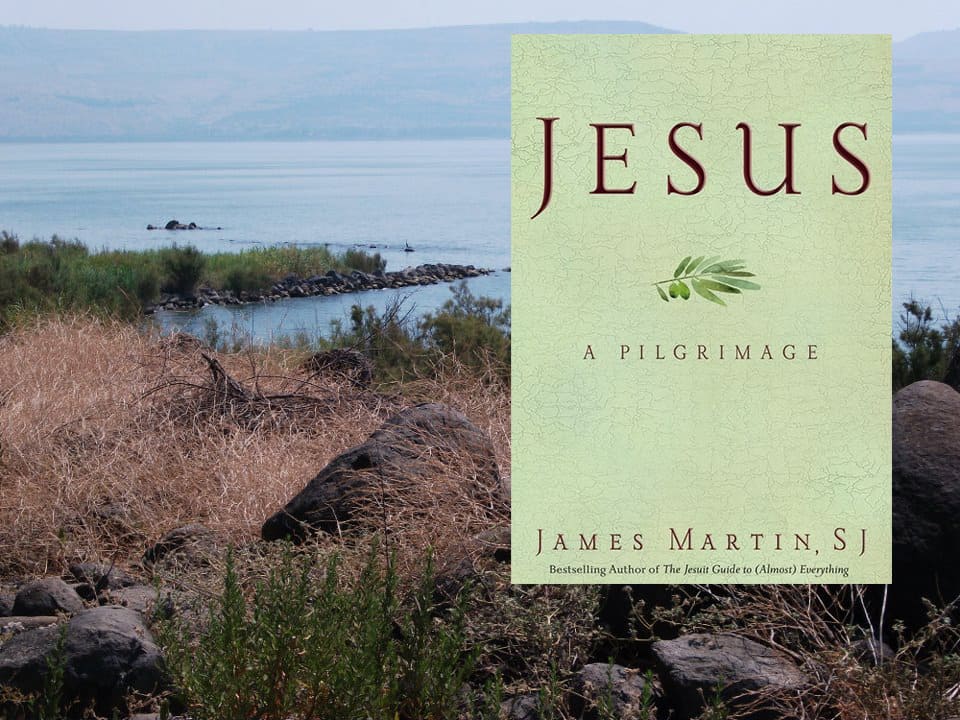|
This post is an exclusive excerpt from the new book Jesus: A Pilgrimage, Published with permission of HarperOne. To purchase print, audio and e-book versions visit HarperOne |
 |
Here’s a story spanning several decades. It shows why it sometimes takes a long time for people (including me) to understand a Gospel story.
The first chapter happened when I was a Jesuit novice. Twenty-five years ago, during the first month in the novitiate, I read about a place called the “Bay of Parables.” While I can’t remember what book this was, I remember the vivid impression it made.
In the Gospel of Luke, Jesus finds himself so hemmed in by crowds that he climbs aboard a boat and asks Peter to row out into the Sea of Galilee, so that he can preach from the shore.1 The Gospels of Mark and Matthew also report incidents of Jesus’s preaching from a boat.2In Galilee, said this book, there is still a place known as the Bay of Parables, where that Gospel passage most likely happened. Near the shoreline is a naturally occurring amphitheater, where people would have been able to sit comfortably to listen to Jesus; moreover, the unique acoustics of the site made it easier for the large crowd to hear Jesus.
The notion that people could identify exactly where a particular Scripture story happened captivated me. I remember thinking: Cool! But the explanation baffled: Why would Jesus get into a boat to address a crowd? (I imagined the carpenter standing up in the boat, wobbling, and falling into the water.) Why wouldn’t he stand on the shoreline? Because of its oddness the tale of the Bay of Parables stuck with me.
The second chapter of my story: A few years later, I was on a summer vacation at a Jesuit house outside Boston, in a town on a bay that empties into the Atlantic Ocean. After breakfast, a few Jesuits would sit on the broad lawn that overlooks a harbor, and spend a relaxing morning reading books or chatting. One morning, we heard a commotion in the harbor, which turned out to be the ruckus from a sailing school for some boisterous kids. The distance between us and the group of miniature sailboats was about a mile.
To my surprise, we could easily hear the kids talking (or whining) as if they were only a few feet away: “I don’t know how to fix my rudder!” “My sail isn’t working!” You could also hear the frazzled instructor encouraging her students: “No, do it this way!”
I remarked how amazing it was that we could hear their voices so clearly. One older Jesuit said, “Well, of course. Sound travels over water very easily. You remember that story of Jesus preaching from the boat, right? That’s one reason he did it that way. It was probably easier for the crowds to hear him.”
His casual insight delighted me. It reminded me that some of what we may not “get” in the Gospel often turns out to have a real-life explanation, once we think about the context of the story. Perhaps because I felt that I’d been let in on a kind of secret, I had a renewed desire to learn more about that story, and about the Gospels.
Finally, the third chapter: my friend George Williams, SJ, and I arrived in Jerusalem about a decade after my encounter with the noisy sailing school. (Read George’s reflections on the trip, and the book, here.) We were spending two weeks on a pilgrimage in the Holy Land. At dinner on the first night, Father Doan, the superior of the Jesuit community where we were staying in Jerusalem, asks me what we’d most like to visit.
The first place I want to see, I tell him, is the Bay of Parables. Doan replies, “The what?” Now, here was a Jesuit priest who has lived in the Holy Land for many years. “I’ve never heard of it.”
Okay, I thought, maybe it’s the one place he hasn’t heard of. George looked doubtful.
A few days later, we made a four-hour drive to Galilee, and found our way to the Franciscan hostel on the Mount of Beatitudes, located right on the shores of the Sea of Galilee. After we settled ourselves in our rooms, the sister who ran the hostel asked us, “So, Fathers, what would you most want to see?”
“The Bay of Parables!” I said.
“The what?”
When I described it, Sister shook her head and furrowed her brow, as if I were deluded. Or insane.
George rolled his eyes and said afterward, “It’s like you were asking about Santa’s Workshop at the North Pole.”
A few hours later, we made our way to Tabgha, the traditional site of the miracle of the Multiplication of the Loaves and the Fishes, and we prayed briefly in the small chapel there. The complex is run by the Benedictines. Afterwards, in the gift shop, I noticed one of the Benedictine monks and screwed up my courage and asked, “Do you know where the Bay of Parables is?” I fully expected him to say, “The what?”
Instead he said in a heavy German accent, “Ja, ja! Zee Bay of Pah-rables!” He stumbled in English, so I called over George, who speaks German. “It’s verry cloze to here,” he said. The monk grabbed a small map from beside the cash register and scribbled some directions. Then George translated his German.
“Just walk along the road and you’ll see…an opening in the bushes. Then go down into the bush and you’ll see…” George paused, looked at the man, looked at me, and then asked him to repeat a word. George said to me, querulously, “I think he said to follow the stones…painted purple?”
“Ja, ja!” he said excitedly, “Wie-o-let. Wie-o-let paint on zee rrocks.”
So under the blistering hot sun—it must have been 110 degrees—George and I followed his map and, sure enough, almost tripped over several boulders marked with violet bars.
“Wie-o-let,” said George dryly.
As we walked further into the dry grass, a handful of wood hyraxes, squirrel-sized rodents, scurried around our feet and zoomed up the low trees.
Immediately the ground dropped away from us, and we found ourselves on the rim of a natural amphitheater. People had likely stood here and listened to Jesus preaching from the boat. Or, as is often said in the Holy Land, “If it didn’t happen here, then it happened a few hundred yards from here.” As I gazed on the blue-green water sparkling under the sun, I could easily picture Jesus sitting in a boat just a few hundred feet from where we were standing. I couldn’t stop smiling when I realized what we had found.
“Zee Bay of Pah-rables,” said George.
Then I saw something that amazed me even more. All around us was this: rocky ground, fertile ground, stony ground, and even a huge thorn bush.
Does that sound familiar? In the Parable of the Sower, Jesus tells the story of a farmer who goes out to sow, and whose seed falls on different kinds of ground. Told in all the Synoptic Gospels, the parable illustrates (among other things) the way that Jesus’s message is received, both in his day and in our own.3
Jesus even explains the parable at length in the Synoptics: the rocky ground represents those who hear the word but do not allow it to take root; when trials come they “wither away.” The thorny ground is an image for those who hear the world but the “cares of the world” and “lure of wealth” choke it off, and the seed produces no yield. But the fertile ground represents those who hear the word and accept it, and who bear great fruit, “in one case a hundredfold, in another sixty, and in another thirty.”4
As I stood under the broiling sun, I was gobsmacked to see rocks, thorns and fertile ground. No one planted the thorn bushes, carted in topsoil or arranged the stones to make the locale look as it did in Jesus’s time, as if we were in a theme park called Jesus Land. They were just there.
It dawned on me that when Jesus used objects from nature to convey his message—seeds, rocks, birds, clouds, water—he may not have been talking in generalities but about these things right here. Not “Think about rocky ground,” but “Look at that rocky ground.” Not “Those people are like thorns,” but “Those people are like those thorns.” It grounded the Gospels, and Jesus, in a way that I never could have imagined. It made me think more about the way Jesus drew on nature in his parables.
Then I remembered another insight I once heard about this passage. The parable of the sower may refer not only to which individuals are open, or not open, to receiving the Gospel message. It may also refer to those parts of ourselves that are open, and not open. Can you see your whole self as the field, and consider what parts are fertile, what parts are rocky, what parts are choked with weeds?
Where, for example, are you open to God’s word in your life? Perhaps you are easily able to find God in your family. That may be your good soil. Where is your rocky soil? Perhaps you are compassionate at home but less so at work, stubbornly clinging to grudges. That aspect of your life may be unyielding, and God’s word cannot penetrate the soil of your soul. What part of your life is choked with weeds? Perhaps you desire to follow God but are obsessed with wealth, which chokes off the fruitful growth that God might wish.
To continue the metaphor, God may want to dislodge a few rocks and pull out some weeds in order to clear a space for his word to take root. This may take the form of a friend confronting you on some selfish behavior, a sudden recognition of your own stubbornness, or a period of suffering that opens you to God in a new way. God plows, unearthing the good soil where God’s word can be planted, take root, grow and flourish.
Facing the Sea of Galilee, I wondered about the people who, in Jesus’s day, sat where I was standing now. What did they think when they heard these parables for the first time? I thought about how glad I was that I had listened my friends and come to the Holy Land. I thought of all of these things as I stood by the Bay of Parables.
From Jesus: A Pilgrimage, by James Martin, SJ, published this month by HarperOne.
Published with permission of HarperOne.
To purchase print, audio and e-book versions: http://www.harpercollins.com/books/Jesus-James-Martin/?isbn=9780062024237
— — — — —


